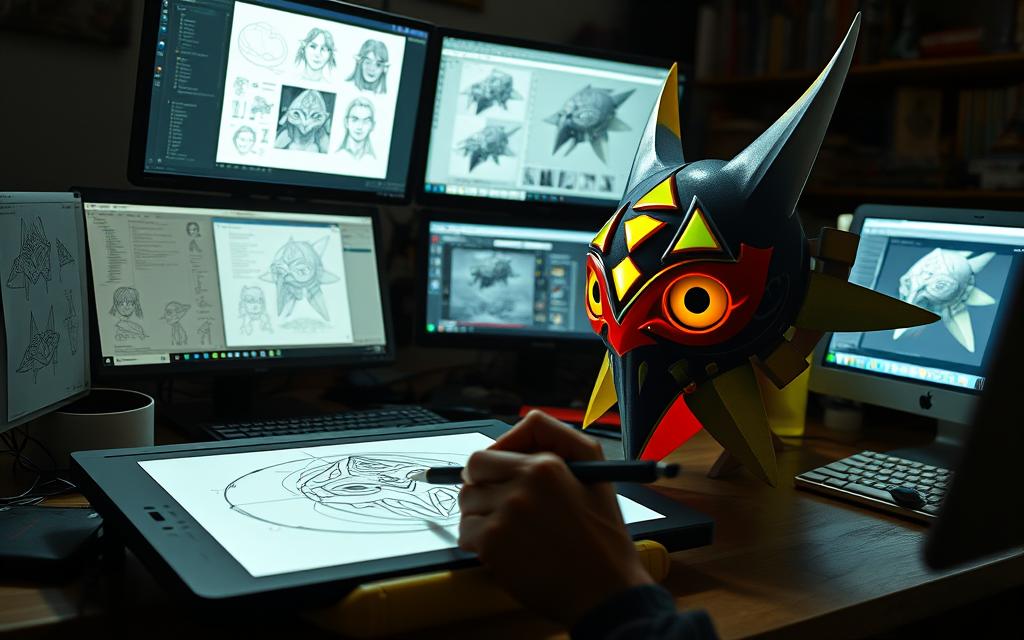Table of Contents
For over three decades, Yusuke Nakano has shaped the visual identity of Nintendo’s most beloved franchises. As the lead illustrator since 1992, his work on The Legend of Zelda and Super Mario series has defined generations of gaming art.
Fans often wonder whether his iconic designs were crafted traditionally or digitally. His career spans from hand-drawn sketches for Ocarina of Time to supervising digital illustrations for modern titles like Link’s Awakening (2019).
Collaborating with legends like Shigeru Miyamoto, Nakano’s style blends American comic influences with Japanese artistry. This exploration delves into his evolving techniques across 33 years of groundbreaking game development.
Yusuke Nakano’s Artistic Journey at Nintendo
Nintendo’s art evolution took a pivotal turn in 1992 when a new talent joined their ranks. Starting in R&D1, he crafted packaging for Wario Land and Super Metroid, blending hand-drawn detail with bold compositions. These early projects honed his signature style—dynamic lines and expressive character designs.
From Traditional Roots to Nintendo’s R&D1
Virtual Boy era print work showcased his adaptability. But it was The Legend of Zelda: A Link to the Past that inspired his Nintendo application. By 1998, his Impa and Ganondorf concepts for Ocarina of Time secured his shift to core game development.
Key Roles in The Legend of Zelda Series
From supervising Capcom’s Oracle titles to leading Twilight Princess’s character designs, Nakano ensured visual consistency across 15+ series entries. His process? Initial sketches, Miyamoto’s feedback, then final assets—a workflow bridging traditional and digital tools.
By 2018, he coordinated art for Super Smash Bros. Ultimate, uniting franchises like Super Mario and Zelda. His legacy spans generations, from N64 manuals to HD remakes.
Did Yusuke Nakano Draw With a Computer? Examining His Process
Behind every iconic Zelda illustration lies a carefully chosen artistic method. The blend of traditional and digital tools in Nintendo’s workflow reflects both nostalgia and innovation.
Traditional Hand-Drawn Art in Ocarina of Time and Majora’s Mask
Ocarina of Time relied on ink and watercolor for its manual illustrations. Scanned artwork preserved the texture of physical media in game manuals and promotional materials.
Majora’s Mask took inspiration from Mike Mignola’s Hellboy comics. Stark shadows and ominous tones defined its characters, crafted entirely by hand before digitization.

Transition to Digital Tools in Later Titles
By 2006, Twilight Princess marked Nintendo’s first full digital pipeline. Wacom tablets replaced scanners, though early sketches still began on paper.
Later projects like Link’s Awakening (2019) proved traditional aesthetics could thrive digitally. Nakano’s team used Clip Studio and Procreate to mimic hand-drawn textures.
This hybrid approach ensured timeless design while embracing modern efficiency. From Ocarina of Time to Super Smash Bros. Ultimate, the evolution speaks to adaptability.
Signature Works and Techniques
Distinctive character designs and collaborative refinement define Nakano’s most celebrated projects. His work on The Legend of Zelda series, particularly Twilight Princess and Wind Waker, showcases a blend of innovation and tradition.
Character Design in Twilight Princess and Wind Waker
Twilight Princess nearly featured a 30-year-old Link, as revealed in Hyrule Historia. Early drafts included chainmail textures and a “wolf cut” for Wolf Link, emphasizing thematic consistency.
For Wind Waker, Nakano reduced the color palette to mirror the oceanic setting. His “color scripting” technique synchronized visuals with story beats, creating a cohesive aesthetic.
Collaborative Input from Miyamoto and Aonuma
Shigeru Miyamoto prioritized silhouette readability—ensuring designs translated well into action figures. Eiji Aonuma focused on narrative cohesion, like functional Zora armor.
The Art & Artifacts book showcases rejected concepts, including elongated-limb Midna. Over 20 Ganondorf sketches preceded his final Ocarina of Time look, proving Nakano’s iterative mastery.
Conclusion: Nakano’s Legacy in Game Art
The fusion of tradition and innovation defines a legendary career in game art. From Ocarina of Time to Super Smash Bros. Ultimate, this artist bridged 2D and 3D eras while preserving Nintendo’s cohesive vision.
Hyrule Historia’s transparent process inspired modern illustrators. Over 450 concept sheets for Twilight Princess set benchmarks for character bibles. Mentorship shaped talents like the Breath of the Wild team.
Definitive Legend Zelda illustrations eternalized classic heroes. Even upcoming titles reference textures from Majora’s Mask. This legacy proves manual and digital tools can harmonize—reshaping game development forever.
FAQ
Did Yusuke Nakano use digital tools for his artwork?
Early in his career, Nakano primarily worked with traditional hand-drawn techniques. Later, he adopted digital tools for titles like Twilight Princess and Wind Waker.
What was Nakano’s role in The Legend of Zelda series?
He contributed to character designs, promotional art, and key illustrations for games like Ocarina of Time, Majora’s Mask, and Hyrule Historia.
How did Nakano’s art style evolve over time?
His early work featured detailed, hand-drawn sketches. Later, he embraced digital refinement while retaining his signature expressive style.
Did Nakano collaborate with other Nintendo artists?
Yes, he worked closely with Shigeru Miyamoto and Eiji Aonuma, blending their creative visions into iconic Zelda and Super Mario designs.
Where can I find Nakano’s artwork?
His illustrations appear in official game manuals, Hyrule Historia, and promotional materials for Nintendo titles.









